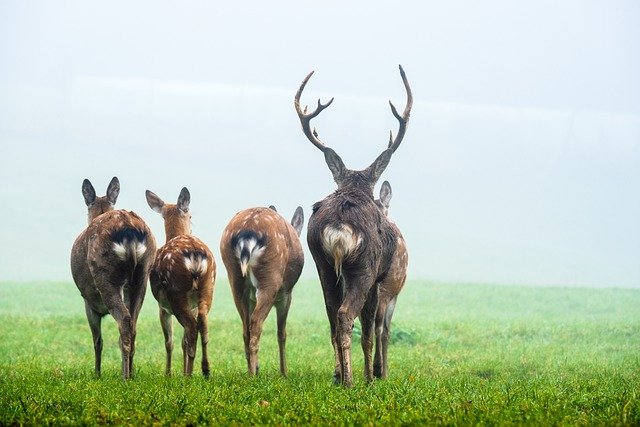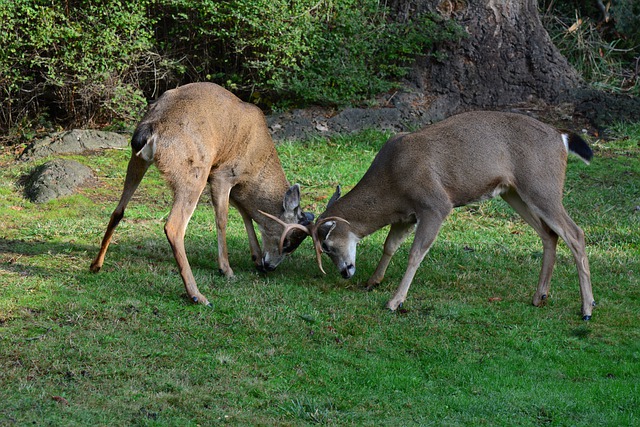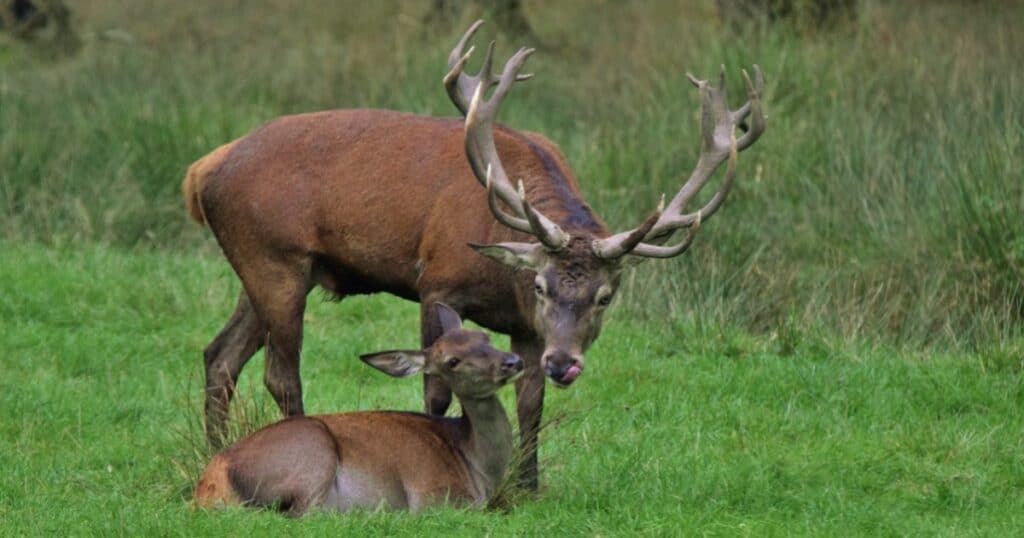Deer reproduction is amongst the natural world’s most interesting cycles. For male deer especially, reproduction is the dominant force in a buck’s life. It occupies much of the year, but specifically when is deer mating season?
All deer reproduce on a seasonal pattern, but distinct species of deer will have different reactions to seasonal changes. The physiology of deer reproduction is crucial to understanding their behavior patterns, such as when they mate.
Other aspects of the deer reproduction cycle, such as velvet shedding and the “rut” are important parts of the breeding cycle.
So, When is Deer Mating Season for Most Deer?
For most deer, mating season begins when temperatures cool and days begin to shorten in the fall. This seasonal change triggers a surge in testosterone among male deer, and it also stimulates female deer to begin estrus. In some parts of the world (like the tropics, for example), there is no distinct mating season for deer since there is little seasonal change in day-length or temperature.
All aspects of the cycle have a practical application, so let’s look at the deer mating season.
Mating Season for Each Deer
Seasonal changes trigger deer’s mating cycles. Deer have instinctual abilities to recognize changes in temperature and day length.

However, there are different breeding seasons for each species of deer.
Whitetail Deer
White Tailed Deer are polyestrous, which means females can be in heat more than once per year. In the most northern reaches of the whitetail range (United States into Canada), females go into heat during November and lasts over 24-hour cycles. However, the whole whitetail mating season is from October to December.
In more southerly climates in South America, whitetails will not be ready to mate until January or February. When a doe is not mated during the first cycle she enters a second estrus period about a month after the first. Whitetail fawns are born in late spring after a near 200-day gestation period.
Red Deer
Red Deer are one of the most widespread deer species. Populations are found in Europe, the Americas, and Africa. Males and females will never interact outside of mating season, since red deer are solitary animals most of the year.
During October, the breeding season brings the opposite sexes together. Famously red deer males do not use antlers to battle during the rut. Instead, they use a roar to attract females, with lower roars gain the female’s affection. Fawns conceived during breeding season will be born in late spring.
Mule Deer
Mule Deer roam the western parts of the United States, including some of the most arid desert regions. They react differently to more subtle seasonal changes as polyestrous and short-day breeders. Peak mating season for mule deer is during November and December.
Mating itself can take several days. The buck and doe spend the time in ritual chase games, remaining together for a short time after mating. Fawns are born after seven months, in late spring and early summer. First-time mothers will birth a single fawn initially, then twins in following years.
Reindeer
Reindeer live in cold climates across the Arctic. Breeding season begins in the first weeks of September and lasts up to a month. Some reindeer located in the harshest climates will start breeding earlier (in August) to ensure nutritional peak in areas where food is scarcer.
Gestation lasts around seven months. Reindeer have perhaps the most famous use of velvet on their antlers to protect and help them grow strong.
Roe Deer
Roe Deer are a European species mostly found in Scotland and the United Kingdom. They begin their mating season at the height of summer, during mid-July. Breeding will continue for a month until mid-August.
However, roe deer exhibit an odd trait, as the mother’s fertilized egg will not start developing until the end of December or early January. This way, they avoid giving birth during the winter months. Overall, it is unclear why mating takes place so many months before.
By May and June, roe deer start giving birth to their young.
Fallow Deer
Fallow Deer are widespread throughout Asia minor, Europe, and the United States. Their mating season occurs from September to November.
October is their most active breeding month. Males will mark off territory and fend off any other buck that enters the area. Fawns are born during late May, through June. Fallow deer doe will usually give birth to a single fawn.
Entering the Rut
While mating season itself is where all the “action” happens, buck deer prepare for breeding for most of their year. Depending on species, the rut is an important part of the mating process, even if there are no does involved. Most people are familiar with the rut, which is the time when male deer compete for the affections of females.

The rut will vary from species to species, though the classic example is deer butting heads in a test of strength. Species with antlers engage in battles that are often violent and aggressive. Other deer species, such as red deer, avoid physical contact during the rut and instead use low guttural roars for competition.
Species with antlers spend half the year protecting their antlers for the rut. Deer, like reindeer, will grow velvet over their antlers which is one of the ways antlers differ from horns. This tissue provides nutrients to the antlers and ensures they are at prime strength in time for the rut. The yearly shedding of their velvet is one of the goriest displays in the animal kingdom.
Once the velvet removed, males are ready to test themselves against other bucks. Deer with the largest and strongest antlers stand more chance of winning in combat; therefore getting the pick of females in their area.


